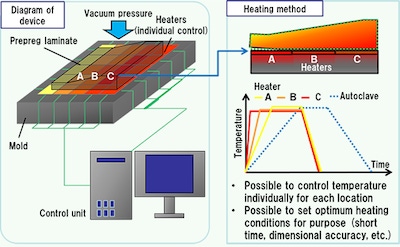Out-of-autoclave process slashes large aerospace component fabrication time by half
Embedded sheet heaters on mold surface are individually controlled; energy saving of around 50% to boot.
April 6, 2018

Toray Industries has developed a new fabrication technology for carbon fiber reinforced plastics (CFRP) that enables both improved dimensional accuracy and energy savings.
CFRP is usually fabricated using an autoclave (high temperature and high pressure furnace) or an oven where prepreg (intermediate material in sheet form) is placed on a mold of predetermined shape and the resin in the prepreg is cured using heated air for fabrication. The conventional fabrication technology has disadvantage that requires long time for heating up and curing due to inefficient heat transfer of heated air and large heat capacity of the mold.
|
Localized heating in out-of-autoclave process reduced dimensional inconsistencies, accelerates fabrication time. |
Challenges in achieving dimensional accuracy also exist, particularly for large, complex-shaped parts with variable thickness from location to location. This is due to the difficulty in controlling temperature distribution throughout the part, which can in turn generate variable residual stresses and sometimes significant part deformation. Due to this, extensive manual work is required during final assembly of multiple parts such as aircraft main wings by manually inserting filler materials called shims, resulting in a longer assembly time than that for fabrication.
The newly developed fabrication technology provides a solution to the problem with a number of embedded sheet heaters on the tool surface that are individually controlled. The part under vacuum is heated effectively from direct contact with the heaters, which achieve energy savings. Further, controlling individual heaters and allowing optimum heat distribution at each location provides even residual stress throughout the fabricated part. As a result, the part can be fabricated as close to the original design with minimal dimensional inconsistencies, which will reduce labor cost and duration of part assembly.
In order to effectively control this heating system, Toray carried out a joint research program with Ehime University and Tokyo University of Science to establish simulation technologies to predict part deformation and optimize heater temperature. Toray combined them into a program for designing heating conditions that would effectively minimize fabrication time and dimensional errors of the parts. Toray installed a prototype fabrication device and is currently conducting demonstration trials.
Depending on the part shape and dimension, it takes about nine hours to fabricate a large CFRP part for aircraft using conventional autoclaves and ovens. The newly developed fabrication technology, on the other hand, is expected to reduce the fabrication time to about four hours. Moreover, this technology achieves about 50% energy saving compared to conventional fabrication methods as pressure and heating media such as heated air is not required. It is also expected to save time during assembly for correctional work using shims because of the improved dimensional accuracy for fabrication.
About the Author(s)
You May Also Like





